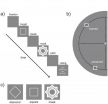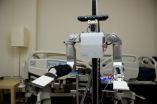(Press-News.org) Our brains process many more stimuli than we become aware of. Often images enter our brain without being noticed: visual information is being processed, but does not reach consciousness, that is, we do not have an impression of it. Then, what is the difference between conscious and unconscious perception, and can both forms of perception be changed through practice? These questions are important not only for basic research, but also for the treatment of patients with perceptual deficits due to brain lesions e.g. following a stroke. Scientists at the MPI for Brain Research in Frankfurt/Main could now show that seeing can be trained. Their tests revealed that the brain regions underlying the learning effects on conscious perception are different than the ones underlying the learning effects on the mere processing of stimuli.
Visual stimuli undergo a series of processing stages on their journey from the eye to the brain. How conscious perception can arise from the activity of neurons is one of the mysteries that the neurophysiologists at the MPI for Brain Research seek to solve. "Today, we know that the processing of stimuli in the cortex remains extremely plastic, or malleable, even in adults," explains Caspar Schwiedrzik who investigates the neural mechanisms of visual perception with his Max Planck colleagues Wolf Singer and Lucia Melloni. In their current study, the scientists examined whether perception can be influenced by long-term and systematic training and whether such training does not only change the processing, but also affects whether the stimulus can be consciously perceived.
It is known from clinical studies that some stroke patients who suffer partial blindness as a result of damage to the visual cortex can discriminate between stimuli that fall into their blind visual field. This unconscious discrimination ability can be improved through training. Nevertheless, the patients report that they do not see the images. In a few cases, however, conscious perception of the stimuli could be improved with training. Is it maybe possible to learn to "see consciously"?
To investigate this question in healthy subjects, the Frankfurt scientists developed an experimental set up with which different learning effects on perception could be measured. The subjects were shown images of two different geometric forms – a square and a diamond – on a screen in rapid succession and in a random sequence, and were asked to discriminate between them. The visibility of the images was limited by presenting a mask shortly after each image, which rendered the shape invisible.
The experiment was designed such that the subjects could initially not discriminate between the images and that they were also subjectively invisible. The subjects were then trained for several days. Each round of the training involved the presentation of images followed by the mask. As soon as the subject indicated by pressing a button which form had been shown and how clearly he or she had seen the form, the next stimulus and the next mask were shown. This process was repeated 600 times per day. After several days, the subjects could better discriminate between the target stimuli. From the ratings of the visibility of the stimuli, the scientists could further conclude that the participants' subjective perception had increased as well: the images now entered consciousness. Thus, the scientists succeeded in demonstrating that it is also possible to learn to see consciously.
The question remained, however, as to how objective and not necessarily conscious processing of stimuli and their subjective, conscious perception are linked. To gain a better understanding of the individual processing steps and to localize them in the brain, the experiment was repeated once more. This time, the image and mask were shown on a different part of the screen, and were thus processed by a different part of the brain. "The results were revealing," explains Lucia Melloni: "While the learning effect for the pure processing of the stimuli, that is the discrimination of the shape, was lost with the spatial rearrangement of the stimuli, the clearer visibility of the images, that is the learning effect in terms of conscious seeing, remained." Therefore, objective processing and subjective perception of the stimuli seem to be less closely linked than previously assumed. The two training effects appear to be based on two different areas of the brain.
"Our experiments have shown that the neuronal processes that underlie conscious perception are very flexible," Schwiedrzik concludes. The findings provide important insights for medical applications, in particular for the rehabilitation of people suffering from perceptual deficits caused by brain lesions.
INFORMATION:
Original work:
Caspar M. Schwiedrzik, Wolf Singer, Lucia Melloni:
Subjective and objective learning effects dissociate in space and in time.
PNAS Early Edition, doi: 10.1073/pnas.1009147108
Learning to see consciously
2011-03-10
ELSE PRESS RELEASES FROM THIS DATE:
How do people respond to being touched by a robot?
2011-03-10
For people, being touched can initiate many different reactions from comfort to discomfort, from intimacy to aggression. But how might people react if they were touched by a robot? Would they recoil, or would they take it in stride? In an initial study, researchers at the Georgia Institute of Technology found people generally had a positive response toward being touched by a robotic nurse, but that their perception of the robot's intent made a significant difference. The research is being presented today at the Human-Robot Interaction conference in Lausanne, Switzerland.
"What ...
Toward real time observation of electron dynamics in atoms and molecules
2011-03-10
Quebec City, March 9, 2011 – Another step has been taken in matter imaging. By using very short flashes of light produced by a technology developed at the national infrastructure Advanced Laser Light Source (ALLS) located at INRS University, researchers have obtained groundbreaking information on the electronic structure of atoms and molecules by observing for the first time ever electronic correlations using the method of high harmonic generation (HHG). Made by a team of researchers from the Energy, Materials, and Telecommunications Center of INRS and the National Research ...
Combating cucurbit yellow stunting disorder virus
2011-03-10
This release is available in Spanish.
U.S. Department of Agriculture (USDA) scientists are working to give melon growers some relief from cucurbit yellow stunting disorder virus, or CYSDV.
In 2006, Agricultural Research Service (ARS) plant pathologist Bill Wintermantel with the U.S. Agricultural Research Station in Salinas, Calif., and university colleagues identified the plant disease that growers in California's Imperial Valley and nearby Yuma, Ariz., noticed was spreading through their cucurbit fields. Cucurbit crops affected included cantaloupe and honeydew melons.
ARS ...
Synthetic biology: TUM researchers develop novel kind of fluorescent protein
2011-03-10
This release is available in German.
Proteins are the most important functional biomolecules in nature with numerous applications in life science research, biotechnology and medicine. So how can they be modified in the most effective way to attain certain desired properties? In the past, the modifications were usually carried out either chemically or via genetic engineering. The team of Professor Arne Skerra from the TUM Chair of Biological Chemistry has now developed a more elegant combined solution: By extending the otherwise universal genetic code, the scientists are ...
Banana peels get a second life as water purifier
2011-03-10
To the surprisingly inventive uses for banana peels — which include polishing silverware, leather shoes, and the leaves of house plants — scientists have added purification of drinking water contaminated with potentially toxic metals. Their report, which concludes that minced banana peel performs better than an array of other purification materials, appears in ACS's journal Industrial & Engineering Chemistry Research.
Gustavo Castro and colleagues note that mining processes, runoff from farms, and industrial wastes can all put heavy metals, such as lead and copper, into ...
An advance toward blood transfusions that require no typing
2011-03-10
Scientists are reporting an "important step" toward development of a universal blood product that would eliminate the need to "type" blood to match donor and recipient before transfusions. A report on the "immunocamouflage" technique, which hides blood cells from antibodies that could trigger a potentially fatal immune reaction that occurs when blood types do not match, appears in the ACS journal, Biomacromolecules.
Maryam Tabrizian and colleagues note that blood transfusions require a correct match between a donor and the recipient's blood. This can be a tricky proposition ...
New study shows government spending preferences of Americans
2011-03-10
In its 27th survey of American spending priorities since 1973 conducted as part of its General Social Survey (GSS), NORC at the University of Chicago Wednesday released a report on its most recent findings. By a notable margin, education and health care were the top two spending priorities of Americans. And Americans are consistent in that: those two categories have finished in the top two in each of the ten surveys since 1990.
The spending priorities report is derived from recently released data of the 2010 General Social Survey which NORC has conducted for forty years. ...
New molecular robot can be programmed to follow instructions
2011-03-10
Scientists have developed a programmable "molecular robot" — a sub-microscopic molecular machine made of synthetic DNA that moves between track locations separated by 6nm. The robot, a short strand of DNA, follows instructions programmed into a set of fuel molecules determining its destination, for example, to turn left or right at a junction in the track. The report, which represents a step toward futuristic nanomachines and nanofactories, appears in ACS's Nano Letters.
Andrew Turberfield and colleagues point out that other scientists have developed similar DNA-based ...
Battling the bedbug epidemic
2011-03-10
Mom's comforting tuck-them-in-words — "Sleep tight, don't let the bedbugs bite"— is becoming an impossible dream for millions of people as the world experiences a resurgence of an ancient scourge that is fostering human misery, financial burdens and the risk of exposure to potentially toxic materials. That's the message from the cover story of the current edition of Chemical & Engineering News (C&EN), ACS' weekly newsmagazine.
In the article, C&EN News Editor William G. Schulz points out that bedbugs represent a growing epidemic that is difficult to control. The bugs ...
Pinpointing air pollution's effects on the heart
2011-03-10
Scientists are untangling how the tiniest pollution particles – which we take in with every breath we breathe – affect our health, making people more vulnerable to cardiovascular and respiratory problems. While scientists know that air pollution can aggravate heart problems, showing exactly how it does so has been challenging.
In a study published recently in the journal Environmental Health Perspectives, scientists showed that in people with diabetes, breathing ultrafine particles can activate platelets, cells in the blood that normally reduce bleeding from a wound, ...

